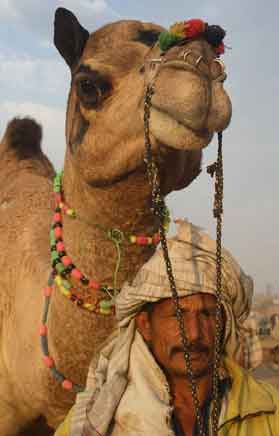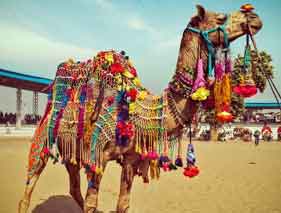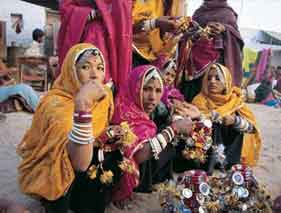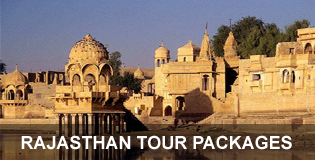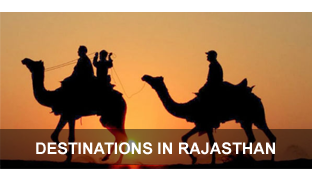Itinerary Details
Day 1 DELHI/MANDAWA:
Depart on the 6-hour drive to Mandawa. Drive through Shekhavati country, a treasure house of old havelis (mansions) with finely carved and painted balconies, depicting old modes of Rajasthani life, historic events and family celebrations. The town of Mandawa lies in the heart of Shekhavati. As you approach it, Mandawa emerges from the sand like a mirage. A painted arched gateway adorned with Lord Krishna and his cows leads to the bazaar. Tie and dye fabrics flutter in the breeze, skilled hands craft colourful bangles in lac and cobblers make leather shoes embroidered with gold thread. Wander through the streets to admire the mansions of the Goenkas, Sarafs, Ladias and Chokhanis with their imposing gateways and elaborate frescoes.
Wind your way through two imposing gateways up to Mandawa Castle. The handsome rugged fort of Mandawa was built in 1755 by Thakur Nawal Singh, who also founded the town of Nawalgarh. Explore the castle and its museum, which houses ancestral costumes, weapons and an impressive collection of coins. There is time to just relax and enjoy the view of the village at sunset from one of the terraces. Overnight at Mandawa.
Day 2 MANDAWA/BIKANER:
After breakfast drive 4 hours through the desert to Bikaner. Stay Bikaner.
Day 3 BIKANER:
Spend the day exploring Bikaner and it environs. Bikaner, founded at the close of the 15th century, stands on high ground, surrounded by fine embattled walls. The 16th century fort contains palaces, temples and a mosque, mostly made of red and yellow sandstone. The marble images are considered to be the finest specimens of Hindu art. Within the massive edifice of the fort, the entrance of which is flanked by two life-size effigies of elephants, are housed some of the rarest gems of Rajput civilization. The Durbar Hall is in Mughal style, lavishly decorated with paintings. Gilt reliefs, glass mosaics and lace- like mirrors adorn the intimate and graceful Zenana - the women's wing, separated from the main palace by a broad courtyard with paneled niches. The Chattris or cenotaphs of the rulers are located some 5 miles (8 km) away. Outside the city are other palaces and temples, imposing edifices of carved red sandstone. Jain temples and monasteries abound in the city and its environs. The famous Camel Corps of the Indian Army, still most useful in desert warfare, are housed in Bikaner. A visit to the Camel Breeding Farm is worthwhile - you could get your first taste of camel's milk here ! Overnight at Hotel.
Day 4 BIKANER/PANCHU:
Drive 3 hours to the village of Panchu and begin the camel cart safari through the great Thar Desert to Bhadla. Overnight camp in the desert.
Day 5 PANCHU/KAKU:
Continue the ride to the colourful Rajput village of Kaku. Overnight camp is set in the compound of the castle of the local rulers.
Day 6 KAKU/JAMBA:
Ride through the desert to Jamba. Visit the old Bishnoi temple. Overnight camping.
Day 7 JAMBA/KILCHEN:
End the safari at Kilchen. Explore this interesting village, renowned for its beautiful havelis, decorated with intricate and fine stone carvings. Overnight camping.
Day 8 KILCHEN/NAGAUR:
After breakfast drive 5 hours to Nagaur, an ancient heavily fortified desert city dating back from the 4th century, which played an important defensive role against Hun and Muslim invaders in the centuries after the disintegration of the Gupta empire. The fort itself is in a state of semi- disrepair but startling evidence of past riches and glory still exists in the elaborately painted ceilings and a profusion of still-vibrant murals. Overnight in the tented camp specially set up for the fair.
Day 9 NAGAUR:
Nagaur is famous for its fine bullocks. Two huge cattle fairs are held here in February and August, when there are four days of races and competitions for camels, cocks, horses and bullocks, with plenty of colourful Rajasthani dancing and singing. Spend the day at the Fair. Overnight camping.
Day 10 NAGAUR/JAISALMER:
After breakfast drive 7 hours to Jaisalmer. Overnight hotel.
Day 11 JAISALMER:
Spend the day exploring Jaiselmer which lies in the western extremity of Rajasthan, in the heart of the Thar Desert. The ancient city, which stands on a low range of hills, surrounded by a stone wall three miles round, was founded in 1156 AD. Within its walls lie temples, forts and palaces, all built of yellow sandstone. The Jain Temples in the fort are decked with deities and dancing figures in mythological settings. The library attached to these places of worship contains some of the most ancient manuscripts in India, some dating back to the 12th century, written on palm-leaf in black ink with hand painted wooden covers. Down in the city are the renowned havelis or mansions of Salim Singh, Nathmalji and the Patwas, every house boasting superb lattice work in innumerable and intricate designs.
In the afternoon drive out to the great Thar desert. A camel ride on the dunes of Sam will give you some idea of the pace and space of desert life. The sun setting over the vast expanse of the desert as folk dancers and musicians entertain you is a breathtaking experience. Overnight hotel.
Day 12 JAISALMER/JODHPUR:
Drive 6 hours to Jodhpur. Overnight at hotel .
Day 13 JODHPUR/DELHI:
Spend the day exploring Jodhpur. This is the land of the valiant Rathore kings, whose courage was a match for the tyranny of the Thar Desert. A bleak scarp rears up 120 meters from the desert valley. Straddling the rocky crevices is the massive Jodhpur Fort, its sheer walls reflecting the strength of its warrior builders. The fort is entered through seven gates, each a formidable barrier. The museum within the fort is one of the finest in Rajasthan and displays royal apparel, ancient paintings and manuscripts, fabled treasures of the royal household and an armoury. An interesting section displays folk musical instruments from different regions of Rajasthan. Delicately latticed windows and pierced screens worked in sandstone form the dominant motif within the rugged casket of the fort and the palaces are exquisitely decorated. On the road down from the fort, the splash of blinding white marble on the left is Jaswant Thada, Maharaja Jaswant Singh II's cenotaph, built in 1899 - all previous rulers have their cenotaphs at Mandore. As with the Taj Mahal in Agra, the marble is from Makrana. The town below has many more fine buildings and temples and is interesting to walk through, particularly the market near the clock tower.
Mandore, which was the capital from the 6th century till 1381 and lies 8 km from Jodhpur. The imposing cenotaphs of the former rulers and ancient temples are surrounded by landscaped gardens. The Hall of Heroes has larger than life figures of Hindu deities or local Rajputs, carved out of rock and painted in gaudy colours. The Temple of the Black Bhairav and White Bhairav - the destructive manifestations of Lord Shiva - have idols pasted over with layers of silver paper.
Evening transfer to the airport to board to board flight for Delhi. Overnight stay in Delhi
Day 14 DEPARTURE DELHI
Today you will get transferred to the airport in time to board flight for onward destination
